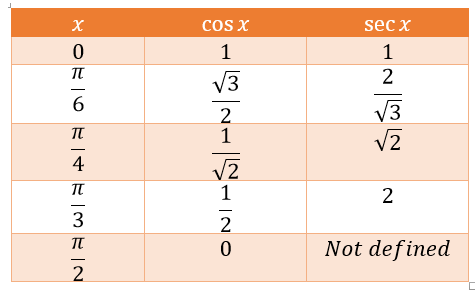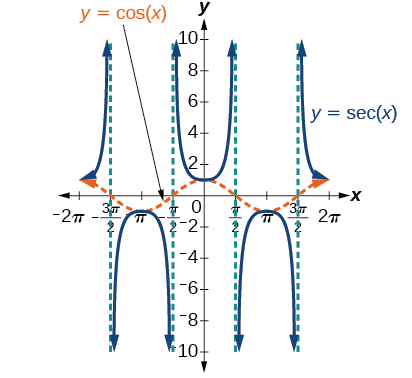How to Graph the Secant Function?
The secant function is the reciprocal of the trigonometric function cosine. In this guide, you will learn more about the graph of the secant function.

A step-by-step guide to graphing the secant function
The secant function is a periodic function in trigonometry. The secant function can be defined as the ratio of the length of the hypotenuse to the length of the base in a right triangle. It is the reciprocal of the \(cos\) function and, is also written as \(sec x = \frac{1}{cos x}\).
Graphing the secant becomes very easy because we already know the cosine graph, so we can easily derive the graph for \(sec x\) by finding the reciprocal of each \(cos\) value. When the value of \(cos x\) is very small, the value of \(sec x\) will be very large. That is, finding \(\frac{1}{y}\) for each value of \(y\) in the curve \(y= cos x\). The table below shows some angles in radians:

We also see that when the value of the \(cos\) function is zero, the secant function goes to infinity, which means that when the cosine value is \(0\), the secant is undefined. So we get the \(sec x\) graph below:

Related to This Article
More math articles
- What is the Best Scientific Calculator for College Students?
- How to Find Function Values from the Calculator
- 7th Grade CMAS Math Worksheets: FREE & Printable
- How to Find the Volume and Surface Area of Rectangular Prisms? (+FREE Worksheet!)
- 6th Grade Georgia Milestones Assessment System Math Worksheets: FREE & Printable
- How to Graph the Cosecant Function?
- How to Graph Polar Equations
- THEA Math Formulas
- 4th Grade FSA Math FREE Sample Practice Questions
- Algebra Puzzle – Challenge 32

















What people say about "How to Graph the Secant Function? - Effortless Math: We Help Students Learn to LOVE Mathematics"?
No one replied yet.